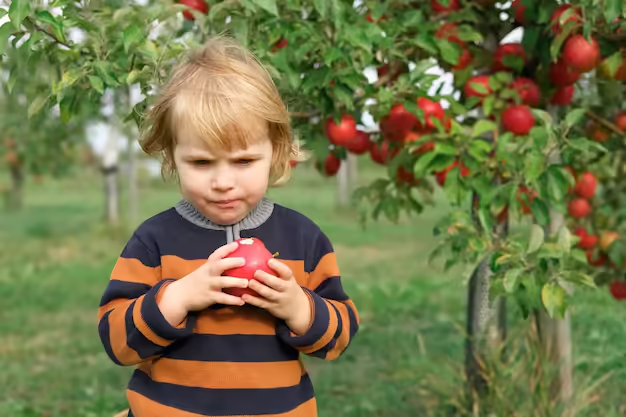
Fall is the perfect time to reap the benefits of gardening and build language skills. Don’t have your own personal garden? That’s okay – we’ve got great suggestions for you too! The activities below are designed to integrate language learning with gardening, allowing kids to pick up new words naturally and enjoyably as they connect with nature. Here are the top 10 fall harvest activities to help your child grow their foreign language vocabulary.
1. Harvest Identification and Labeling
Encourage your kids to participate in identifying and labeling the fruits and vegetables they harvest. Create labels for fall produce like pumpkins, squash, apples, and corn in both your native language and the foreign language you’re learning. For example, label your pumpkins as “Pumpkin/Calabaza” (English/Spanish).
Here’s how to get started:
- Draw and Color: Encourage your little ones to draw a picture of each plant, like a tomato, and color it in.
- Write the Names: Help them write the plant names in both languages.
- Use Bright Colors: Choose colorful markers to make the labels fun and eye-catching.
- Durable Tags: Use sturdy tags so they last all season long.
This activity helps children learn the names of seasonal produce and other related terms.
2. Reading Seed Packets and Harvest Instructions
Use seed packets and harvest instructions to teach basic gardening terms. As you harvest your crops, sit with your child and read the instructions on how to store or prepare them. Highlight simple words like “harvest,” “pick,” and “store” in the target language. Turn this into a game by matching the words to pictures or drawing each step.
3. Creating a Fall Garden Journal
Have your child keep a garden journal specifically for the fall harvest. They can draw pictures of the fruits and vegetables they’re harvesting, describe their colors, and note down the weather conditions affecting the garden. This practice reinforces vocabulary related to plants, colors, shapes, and weather.
Ideas for Your Garden Journal:
Fruit and Vegetable Names:
Draw pictures of the fruits and vegetables you’re growing and label them in both languages.
Colors:
Describe the colors of different plants, flowers, and vegetables.
Shapes:
Point out and draw different shapes you see in the garden—like round tomatoes or oval cucumbers.
Numbers:
Count the number of plants, fruits, and flowers in your garden.
Comparisons:
Make comparisons like big vs. small, tall vs. short.
Weather Words:
Write and talk about the weather conditions affecting your harvest—sunny, rainy, cloudy.
Vocabulary Focus:
- Descriptive words (colors, shapes)
- Basic arithmetic (counting)
- Weather-related terms
4. Harvesting with Friends
Invite friends to join in on the fall harvest. As they pick apples or gather leaves, encourage them to use a foreign language to name what they’re collecting. For instance, they could say “Collect the apples” or “Rake the leaves” in the target language. Social interaction makes language learning more engaging and fun.
5. Visiting Pumpkin Patches and Apple Orchards
A visit to a pumpkin patch or apple orchard can be an exciting way to practice new vocabulary. Set up a scavenger hunt with a list of fall items to find using the foreign language. As you explore, use the target language to describe the different types of apples or pumpkins, making vocabulary acquisition more dynamic and memorable.
6. Participating in Fall Harvest Workshops
Look for workshops that focus on fall harvest activities like apple picking or pumpkin carving. These events often include fun activities that are perfect for practicing new vocabulary. Encourage your child to use and repeat new words while engaging in hands-on learning.
7. Reading Fall Harvest Books and Magazines
Introduce your child to books and magazines that focus on fall harvests in a foreign language. Choose picture books with simple sentences and vibrant illustrations that feature seasonal themes like harvesting, cooking, or preparing for winter. This helps your child associate new words with the fall season and everyday activities.
8. Creating Harvest Care Guides
Have your child create care guides for the fall produce in your garden, like how to store apples or cure pumpkins. They can illustrate and write simple instructions in a foreign language. This activity reinforces vocabulary related to harvest care and provides a handy reference.
Conclusion: Growing Vocabulary Through the Fall Harvest
Fall harvest activities offer a fantastic opportunity for children to learn and grow in many ways, including expanding their foreign language vocabulary. By incorporating these activities into your fall routine, you can help your child build a strong vocabulary while enjoying the bounty of the season. Start today and watch your child’s language skills blossom as they explore the wonders of the fall harvest! Happy harvesting and happy learning!
Fancy some free resources?
Experience everything One Third Stories has to offer with an ebook, audiobook and activities delivered right to your inbox.



Choose a language
Our courses are available in French, Spanish, Italian and German.
Select a subscription
Choose between monthly or annual payment options.
Start learning
Receive your first audiobook and Story Box, and let the learning begin!.

Choose a language
Our courses are available in French, Spanish, Italian and German.

Select a subscription
Choose between monthly or annual payment options.

Start learning
Receive your first audiobook and Story Box, and let the learning begin!.
